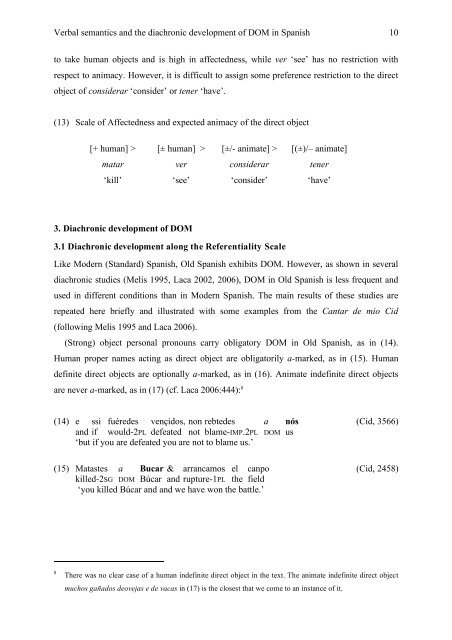Verbal Semantics and the Diachronic Development of Differential ...
Verbal Semantics and the Diachronic Development of Differential ...
Verbal Semantics and the Diachronic Development of Differential ...
Create successful ePaper yourself
Turn your PDF publications into a flip-book with our unique Google optimized e-Paper software.
<strong>Verbal</strong> semantics <strong>and</strong> <strong>the</strong> diachronic development <strong>of</strong> DOM in Spanish 10<br />
to take human objects <strong>and</strong> is high in affectedness, while ver ‘see’ has no restriction with<br />
respect to animacy. However, it is difficult to assign some preference restriction to <strong>the</strong> direct<br />
object <strong>of</strong> considerar ‘consider’ or tener ‘have’.<br />
(13) Scale <strong>of</strong> Affectedness <strong>and</strong> expected animacy <strong>of</strong> <strong>the</strong> direct object<br />
[+ human] > [± human] > [±/- animate] > [(±)/– animate]<br />
matar ver considerar tener<br />
‘kill’ ‘see’ ‘consider’ ‘have’<br />
3. <strong>Diachronic</strong> development <strong>of</strong> DOM<br />
3.1 <strong>Diachronic</strong> development along <strong>the</strong> Referentiality Scale<br />
Like Modern (St<strong>and</strong>ard) Spanish, Old Spanish exhibits DOM. However, as shown in several<br />
diachronic studies (Melis 1995, Laca 2002, 2006), DOM in Old Spanish is less frequent <strong>and</strong><br />
used in different conditions than in Modern Spanish. The main results <strong>of</strong> <strong>the</strong>se studies are<br />
repeated here briefly <strong>and</strong> illustrated with some examples from <strong>the</strong> Cantar de mio Cid<br />
(following Melis 1995 <strong>and</strong> Laca 2006).<br />
(Strong) object personal pronouns carry obligatory DOM in Old Spanish, as in (14).<br />
Human proper names acting as direct object are obligatorily a-marked, as in (15). Human<br />
definite direct objects are optionally a-marked, as in (16). Animate indefinite direct objects<br />
are never a-marked, as in (17) (cf. Laca 2006:444): 8<br />
(14) e ssi fuéredes vençidos, non rebtedes a nós (Cid, 3566)<br />
<strong>and</strong> if would-2PL defeated not blame-IMP.2PL DOM us<br />
‘but if you are defeated you are not to blame us.’<br />
(15) Matastes a Bucar & arrancamos el canpo (Cid, 2458)<br />
killed-2SG DOM Búcar <strong>and</strong> rupture-1PL <strong>the</strong> field<br />
‘you killed Búcar <strong>and</strong> <strong>and</strong> we have won <strong>the</strong> battle.’<br />
8<br />
There was no clear case <strong>of</strong> a human indefinite direct object in <strong>the</strong> text. The animate indefinite direct object<br />
muchos gañados deovejas e de vacas in (17) is <strong>the</strong> closest that we come to an instance <strong>of</strong> it.

















